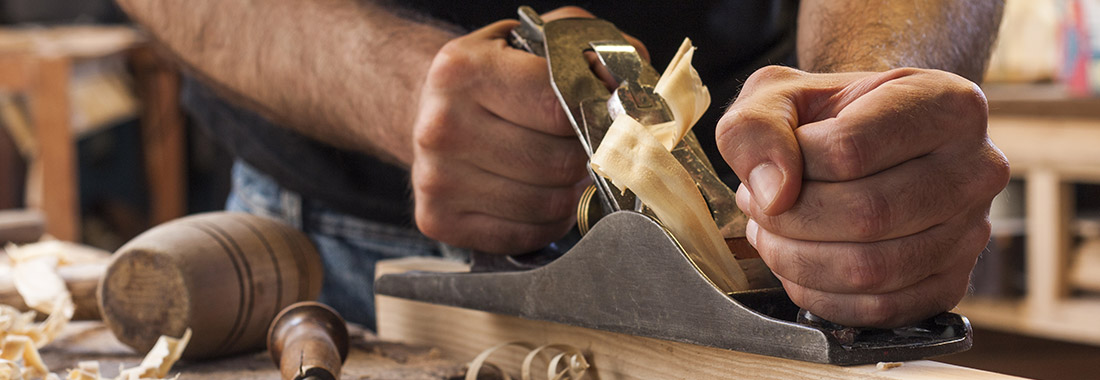

The basic design of the conventional wood plane has remained unchanged for generations. In this introductory guide, we’ll be taking a look at both the anatomy of the plane and the various different types of wood planes currently available.
What are wood planes?
The concept behind the wood plane is relatively simple, though how it is accomplished is more elaborate. On the interior of a wood plane is a large wedge known as a ‘frog’. This is responsible for supporting and holding the blade in the required position. The blade runs through the plane interior and emerges through the ‘mouth’ at the bottom, protruding slightly lower than sole.
Fastened to the top of the blade is a cap iron or chipbreaker, which ensures that the wood shavings curl and break after travelling upwards through the mouth. There is also a depth adjustment knob to control the length of the blade, a primary handle, a lateral adjustment lever and a second handle (or knob) to the front.
Though there are variations in design from one plane to the next, the basic purpose and principles of wood plane design remain unchanged.
Different types of hand plane
We’ll now take a look at some of the most popular and widely used planes on the market, each designed with a slightly different application in mind:
Block
These are relatively small planes (around 15cm long) that can be used easily with one hand. Block planes create shallow cuts to leave behind a smooth and even finish. They are often used towards the end of a carpentry project.
Smoothing
Smoothing planes are designed specifically to perform final finishing cuts when working with boards and wooden surfaces. They are available in a variety of sizes (classified by length) and capable of smoothing and finishing surfaces evenly and precisely.
Jack
True to its name, this is the ultimate “Jack of all trades” that has been designed to tackle many different carpentry jobs. Perfect for smoothing and flattening out uneven boards with a more aggressive action, the Jack plane is exceptionally versatile and comparatively easy to use. It usually measures around 35cm in length, though this may vary from one product to the next.
Fore
A fore plane is designed primarily for flattening and typically measures in at a much larger 46cm. The sole is specifically designed to ensure that the blade does not cut into any troughs present on an uneven board. Instead, a fore plane exclusively addresses peaks to even out the surface.
Jointer
The largest of the standard wood planes, jointer planes can measure up to 60cm in length. They are designed with heavy-duty smoothing and cutting in mind. A good jointer plane can make light work of even the biggest and most challenging of surfaces.
Surform block
This is an entirely different type of hand plane. Surform block planes feature a specially moulded plastic body, to which a reversible blade is attached for general planning and bull nose work. Surform block planes are compatible with all different types of wood, plastics and laminates. They are also suitable for working with with metals such as copper and aluminium.
Tips for using a wood plane
After selecting the ideal plane for your project, consider the following tips and guidelines for consistently superior results:
1. It is best to vary the part of the plane you exert the most pressure on across the length of the cut. Start out by focusing the most pressure on the toe (front) of the plane, before centralising the force through the middle of the cut. Finally, place more pressure on the heel (back) towards the end of the stroke.
2. The chipbreaker’s edge should the positioned a maximum of 0.8 mm from the blade’s cutting edge. This will ensure it breaks the wood cuttings as they pass through the mouth while adequately supporting the blade. This will contribute to smoother cuts and more even results.
3. If you are using a smoothing plane, problems with gouging and unsightly results can be eliminated by rounding off the sharp corners of the blade with a smoothing plane.
4. Always keep a close eye on the sharpness, positioning and general integrity of the blade at all times. If there are any signs that your blade is losing its sharpness or strength, sharpen or replace it as soon as possible.
Sharpening a wood plane blade
Plane irons can be sharpened relatively easily using a grinding machine, a diamond stone, an oil stone or a waterstone. Before fitting a new blade to your wood plane, carefully flatten and polish the cutting bevel, The back of the plane will also need polishing prior to using it for the first time.



